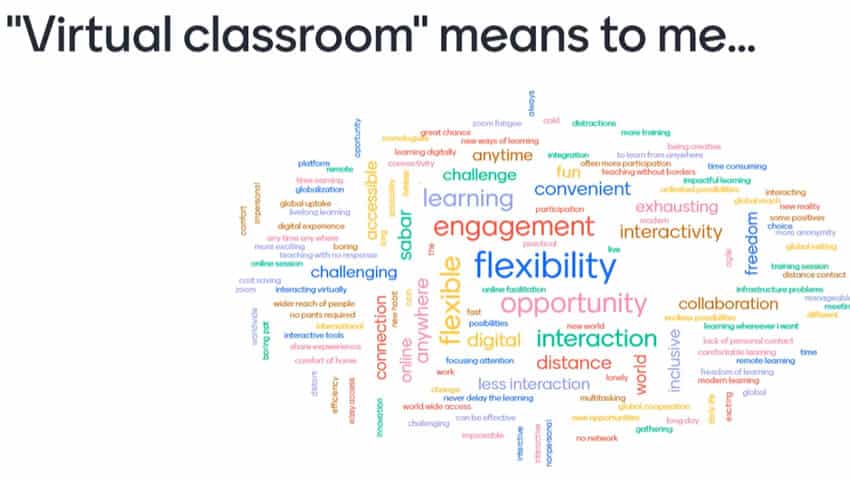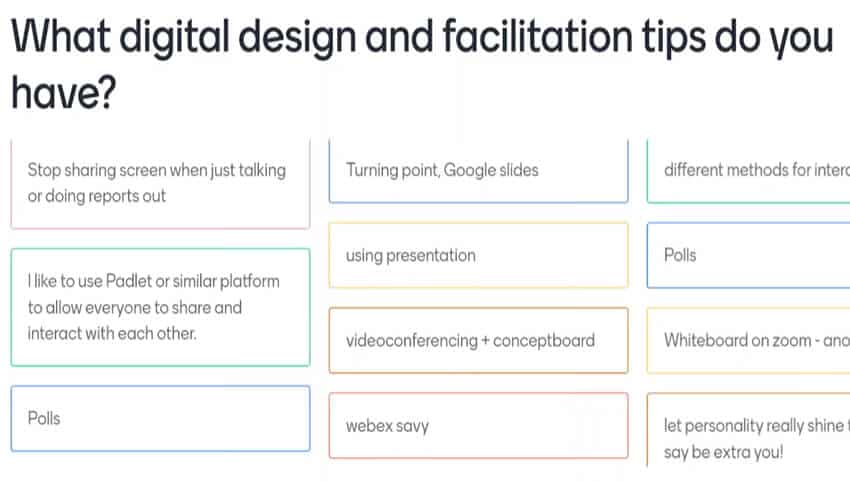
The demand to deliver online training to our workforce is increasing and virtual classrooms are becoming more and more common as the preferred interactive learning and training method for business.
However, many L&D professionals find themselves at a loss with knowing where to start when it comes to online training. Do traditional training practices such as face to face instruction translate to virtual? Is it possible to ensure engagement in virtual sessions? What does an effective online/virtual classroom look like?
In this blog post, we will discover the three most common misbeliefs that prevent learning and development professionals from delivering effective online training.
What is online training and what are the advantages?
Online training is a virtual training method used by accessing lesson material through the internet. Online training is best known for the accelerated knowledge transfer of specific subjects regardless of time or physical location.
Digital skills training has been available for since the early age of the internet, offering higher education opportunities during the early ages of the internet.
A few reasons why offering online learning and training opportunities were so appealing even from early on were because of:
- Flexibility
- Accessibility
- Mobility
- Price
- Reporting
Indeed, technology has shaped the way we now think of learning and training, not only when it comes to education but also when it comes to the workplace.
Online training and virtual classrooms
Virtual classrooms are becoming more popular as global pandemic continues to force us to rethink the idea of face-to-face training. But as the popularity grows, it is becoming more apparent that the difference between a virtual classroom and a great virtual classroom experience can make all the difference when it comes to effective learning.
For that reason, we decided to speak to longtime virtual classroom expert, Jo Cook.
Jo is an instructional designer, classroom facilitator and passionate speaker who specializes in virtual classrooms, webinars and live online learning technology.
In her experience this past year, she witnessed some companies who were able to move to digital learning with ease, as they had already dipped their toes into virtual training realm far before the pandemic hit.
At the same time, some companies found getting completely onboard with making the switch to digital learning much more challenging.
In this interesting webinar, How to Improve Your Virtual Classroom, Jo guides us through what goes into a truly effective virtual classroom experience.
Based on these learnings, we discovered what common misconceptions there are when it comes to virtual training, and what L&D can do to delivering the best online training for our employees.
Top 3 points missed in online teaching and training
Here are the three most common misconceptions that learning professionals have when rolling out virtual classrooms in their organizations.
1. Forgetting to focus on existing skills
One of the biggest things that people miss when delivering online training and learning is that people tend to aim too big, deterring them from achieving their desired results. In our webinar with Jo Cook, Jo advises to start where your skills and experiences already are. Focus on the skills you have already and how you want to facilitate the learning discussions and the activities in your sessions.
One example of this would be using the chat function.
Everyone’s technology levels are different, so starting small increases the likelihood that more people will be open to using something they are already familiar with. Ultimately, the small wins with technology will grow more confidence with using new and more advanced technology.
But no matter what you do, your learning strategy should start with the business goals first, and then you can delve into the technology part.
For this, Jo suggests using Cathy Moore’s Action Mapping Approach. This method involves everyone focusing on what people actually do at work, allowing you to better explain how technology applies to your learning plans and online delivery.
Remember, your learning design and facilitation skills that you use for your live training sessions can be transferred over to your virtual training sessions.
Online training still requires:
- course material preparation
- participation from attendees
- awareness if concepts are being well received and understood
Keep in mind, however, that there are differences between these two types of training methods which require different approaches and considerations. Take it from Jo, who recommends to “start thinking about your design like you do for face-to-face.”
In the end, use your existing skills and adapt them to what technology can offer.
2. Assuming that face-to-face applies to virtual classrooms
Think about it. Children of today are possibly the first and only generation (thus far) to learn completely online. For the rest of us, a live classroom may bring about nostalgic feelings of silently sitting in a room with our peers, listening to our instructor and taking notes, and maybe some of us eagerly looking at the clock, desperately waiting for the hour to end.
No matter your personal feelings about live classroom sessions, the fact of the matter is they are no longer a viable (or safe) option for our learners.
Although traditional training has its strengths, there was always room for improvement.
As Jo says in the webinar, “an overused strength can be a weakness.”
There are many benefits for both the business and the learner when it comes to virtual classrooms, but many providers are still missing the mark when it comes to an effective virtual classroom session.
Why? Because many still maintain the belief that a virtual classroom is still a physical classroom, just online. This past year has proved that this is not the most optimal way to approach digital training.
This mindset prevents you from experiencing the great advantages of having technology at your disposal. Moving from face-to-face to digital is not as easy as flipping a switch, but there are ways to get started.
One example Jo references in her webinar is the use of a chat window in a virtual session. This way, the participants can exchange ideas and share information without interrupting the session. In a physical classroom, this would not be considered proper classroom etiquette, and could also be interpreted as rude and disruptive.
You also have more options for classroom engagement by having the facilitator ask the group to put their answers to a question in chat without anyone being left out or being spoken over.
By holding on to this idea of “virtual sessions are just classrooms, only online”, you’ll be missing out on the various opportunities for engagement – giving the attendees the best possible session and our facilitators the opportunity to hold the best possible session.
3. Not working with partners/professionals
Those working in L&D many years know that driving organizational change in the workplace is no easy feat. There are many obstacles to overcome in order to position learning a strategic asset for the business.
Luckily, you don’t need to take on this challenge alone!
Digital transformation leaders such as Speexx or Lightbulb Moment have the knowledge and experience to help you provide the most effective virtual training that meets your specific needs.
Where to start with online training
Not sure where to start? Working with an experienced partner removes any mystery around technology or gives you the advantage of bridging the digital knowledge gap without roadblocks.
Whether you decide to partner with an expert or if you outsource to other internal teams, Jo offers the following tips:
- Be clear with where you are and where you want to be.
- Focus on the business needs.
- Define behavior change and don’t forget the resources you already have at your disposal.
- Know your budget. This will determine what resources are available to you at the time.
- Know the timing. You know your staff’s needs the best. Use your own knowledge and experience to recommend what time of day and how long sessions should be for your employees.
- Look for vendors who have specialized in online training and delivery before 2020. Remember, Zoom and Teams usage increased significantly during the pandemic. Those claiming to be experts in these software products might not have as much experience as they claim.
Online training is here to stay
Whether we want to admit it or not, online training and learning is here to stay. Offering professional virtual training sessions demonstrates to our workforce that learning is a priority, regardless of the situation.
Virtual classrooms will continue to benefit businesses even as we slowly come out of lockdown, whether it’s in the form of cost reduction or retaining employees through reskilling/upskilling efforts.
Focusing on the quality of live online will improve skills development and using the best of traditional training and technology will improve your online training and delivery for the future.
If you’re interested in hearing more about improving your virtual classroom and online training delivery, please check out the recording of our webinar with Jo Cook here: How to Improve Your Virtual Classroom.


